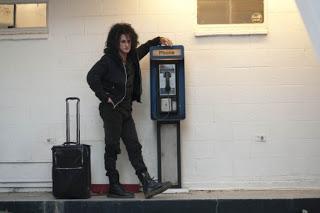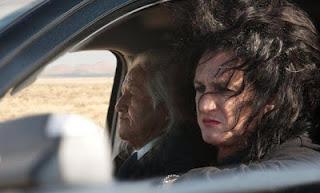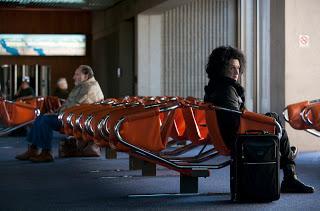 Paolo Sorrentino is definitely a talented director. His films considerably rely on visual statements. Sorrentino’s This Must Be the Place indirectly urges the film’s viewer to observe the details of visual statements, which often put in context the quaint sense of humor of the spoken word in the film. That does not mean the viewer should miss the quirky spoken words either, such as the deadpan non sequitur "Why is Lady Gaga?" The most important lines, stated nonchalantly, come mid-way into the film and those lines are the key to understanding it:
Paolo Sorrentino is definitely a talented director. His films considerably rely on visual statements. Sorrentino’s This Must Be the Place indirectly urges the film’s viewer to observe the details of visual statements, which often put in context the quaint sense of humor of the spoken word in the film. That does not mean the viewer should miss the quirky spoken words either, such as the deadpan non sequitur "Why is Lady Gaga?" The most important lines, stated nonchalantly, come mid-way into the film and those lines are the key to understanding it: “You have to choose a moment in your life to be not afraid.”“And have you chosen that moment?”“Yes, I have.”
Those critical lines explain the entire film for those who might find the film exasperating to understand, beyond the obvious strands of the film being a cocktail of a road movie, a detective movie and a Nazi-criminal-hunt movie. It also a vengeance movie but one that presents the antithesis of violence one associates with Hollywood vengeance movies, a la Quentin Tarantino. The film is perhaps best described as a psychological study about individuals who wear masks and are able to remove their masks when they are no longer afraid and ultimately realize they don’t need masks to survive. The film also gives importance to the time and place when a life-changing moment in one’s life allows for an important u-turn in your life, a point in life when you mentally grow up.

Cheyenne (Penn) and wife (McDormand)
This Must Be the Place is an unusual film and for many viewers half an hour into the film will probably make them cringe away from looking at the screen and instead glance in the wrong direction—the exit door. One is likely to have similar urges with Sorrentino’s spectacular and more complex work The Consequences of Love (2004) as well. However, if you have some forbearance, both films will prove to be audacious, intelligent and rewarding provided you stay glued to the screen right up to the end of the film. And if you do stay right up to the end, you are likely to be delighted to have viewed cinema of a distinct and unusual quality and re-evaluate the early bits of any Sorrentino film in a totally new light once the movie gets over. That is the amazing talent of Sorrentino. And Sorrentino is only 42!
Sorrentino is an Italian who has made his name with works totally Italian. And yet his latest film which is only his fourth feature film, This Must Be the Place is remarkably different: it is in English language, with Hollywood actors, and capturing Americana as an American director would to the bone. But the movie retains its European directorial style, just as German Werner Herzog made Stroszek (1977) or German Wim Wenders who made Paris, Texas (1984) and decades later followed up with The Million Dollar Hotel (2000) in USA utilizing several Hollywood stars, some of whom were already major actors elsewhere before they became to be known as Hollywood stars.

Fear of flying
This Must Be the Place has major Hollywood stars—Sean Penn and Frances McDormand. And Sean Penn does an amazing turn as a burned out Goth Rock star, a character that is bizarre but will remain indelible in the minds of most viewers. Sean Penn wears lipstick, eyeliners, and a weird hairdo and talks slowly in a manner one associates with drug addicts. You begin to wonder initially if Penn is playing a transvestite and then you realize he is not. He is just a rock star caught in a time warp and living retired life in Dublin, Ireland, as though he is still mentally on stage before a live audience of screaming fans. We soon realize he is not dangerous but an innocent and well-meaning husband with strange tastes for his appearance. But Penn and Sorrentino create another dimension: Penn speaks slowly but in unusually high pitch in this role and what he speaks is never tripe but often measured words of wisdom. When being served a cheeseburger, the waitress converses with Cheyenne (Sean Penn) and apologizes that the burger is a bit too well done. “You don’t mind, do you? Unfortunately that’s life” she adds. Cheyenne’s deadpan response is “You know what the problem is...we go on from an age where we say ‘My life will be that’ to an age where we say ‘That’s life’.” Or take another case when Cheyenne is offered a cigarette he responds “Smoking is only for kids who haven’t grown up.” Now that is Sorrentino and co-scriptwriter Umberto Contarello at work. All these lines tell you that the film is definitely more than a road movie, a detective movie and a Nazi-criminal-hunt movie.

Making contact, when in trouble, with his wife
The opening shots of Sean Penn applying lipstick and eyeliner and sporting the weird hairdo of Goth Rock musicians give the viewer a clue. This is a mask of a troubled mind. But then the clues of what is bothering Cheyenne only slowly tumble out. Despite the lovely house in Dublin (evidence of sufficient financial security) and a 35 year old stable marriage with a loving wife (Frances McDormand) who is a fire-fighter and loves “saving lives”, it is easy for the viewer to note that Cheyenne is carrying heavy emotional baggage. We first learn that two teenage kids committed suicide due to the lyrics of Cheyenne’s songs and this has affected him. Then we learn of his fractured relationship with his father in USA, who is a Holocaust survivor on his deathbed. We also note that an old woman and Cheyenne’s not-so-cheerful neighbor in Dublin hates the sight of the old pop star every time he passes by her window because she associates Cheyenne with her son who has left her for a long while. And we realize that Cheyenne understands her pain: he himself is suffering the pangs of a broken father-son relationship.
This Must Be the Place is a film that suggests violence but does not show it—in fact the film is an ode to non-violence. Sorrentino’s original script has some lovely comments about the easy purchase of guns in USA. In a gun shop, in the film, a customer comments: “If we are licensed to be monsters, we end up with only one desire--to truly be monsters.” These are the gems of a Sorrentino film that makes you think.
Sean Penn and Sorrentino build up Cheyenne’s character with great care—it is part feminine, part childlike. The character is only deceptively childlike. When someone remarks “Didn’t you use to drink a lot?” Cheyenne answers, “Enough to decide to stop.” The adult in Cheyenne is revealed by the uncanny detective skills he employs to reach his target—a Nazi criminal. He meets the Nazi criminal's wife as though he is an old student of hers. He meets his Nazi criminal’s daughter and grandchild and even sings a song at their request. To locate his Nazi, Cheyenne chats up the inventor of adding wheels to bags (played by Harry Dean Stanton, a mild reference to Wenders’ movie Paris, Texas).

With a native Indian
As a road movie, there is even a silent but evocative drive with a silent native Indian and a ping pong game where Cheyenne teaches youngsters the finer points.
Without revealing the crucial outcome of the Nazi-criminal and Cheyenne meeting, the more important aspect is how it transforms Cheyenne. He has a haircut. He is able to walk in Dublin with an energy that eluded him before his trip to see his estranged father in USA. He can look straight in the eye of his neighbor looking at him out of her window. Cheyenne has not just physically changed, he has changed psychologically. He has dropped off the emotional baggage. And the best part of the Sorrentino tale, the old woman gets transformed by the sight of the new Cheyenne. She is able to see that one day her own son could also return to her, transformed as Cheyenne has.

The visual tale
What is remarkable about This Must Be the Place to make it one of the finest films of 2012? Apart from the obvious remarkable performance of Sean Penn and Sorrentino’s story/screenplay/direction, it is the film’s ability to raise the quality of cinema by its images. All the four Sorrentino films released so far have Luca Bigazzi, the cinematographer, making his definite imprint on the viewer. Bigazzi’s outdoor crane shots and the long shots come alive on the big screen. Both in The Consequences of Love and This Must Be the Place (the only two Sorrentino films that this critic has seen) the alienation of the main characters are accentuated by their physical loneliness captured on camera with no individual in proximity. Even when filming scenes indoors, Bigazzi/ Sorrentino capture the loneliness with large spaces and distances. My favorite scene is of Penn/Cheyenne sitting alone in a darkened room watching slides and as the slides change the camera captures his face and the discrete changes in emotions, punctuated by the total darkness that merges with his black hair. A remarkable and clever sequence involving camerawork, screenplay and editing is how the scene of David Byrne singing the title song is introduced into the film that begins with woman sitting in an armchair in a closed room with the visuals taking you to David Byrne performing and Cheyenne commenting on the song to Byrne. However, in scenes where Penn and McDormand are together there is not much of distance separating them as they are evidently portraying a happy couple. (In an interview, Sorrentino revealed that the close relationship and understanding in the film between Cheyenne and his wife is built on Sorrentino’s own relationship with his wife.) Even in the shot of Cheyenne returning from the US approaching the window of his neighbor who had earlier despised him the physical distances between them appear to be reducing. Every shot in the Sorrentino films reminds one of the visual distances you encounter in films of Antonioni.

Cheyenne is hyperactive playing handball with his wife in an empty swimming pool
This Must Be the Place might not be as great a film as The Consequences of Love but it definitely proves that Sorrentino, Penn and Bigazzi are each remarkable in their own individual but versatile contributions they have made to this lovely film. The film deservedly won the Ecumenical Jury prize at the Cannes Film Festival 2012.
P.S. This Must Be the Place is one of the top 10 films of 2012for the author. Sorrentino’s The Consequences of Love has been reviewed earlier on this blog.
<a href="http://feedjit.com/">Feedjit Live Website Statistics</a>

